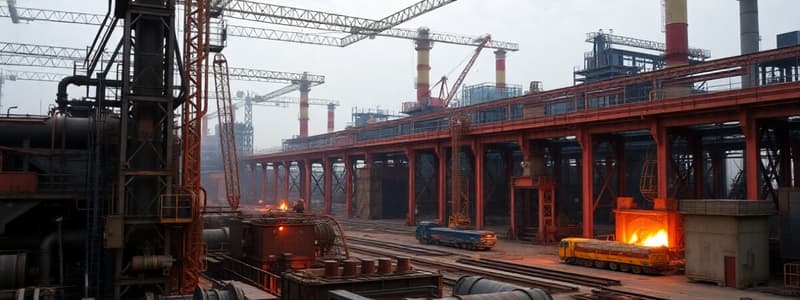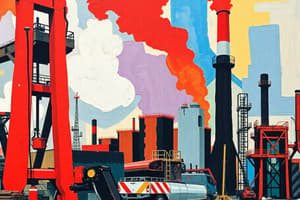Podcast
Questions and Answers
What was a key factor that influenced the coastal shift of the iron and steel industry in China during the 1980s to early 2000s?
What was a key factor that influenced the coastal shift of the iron and steel industry in China during the 1980s to early 2000s?
- Increased availability of iron ore
- Government policies promoting coastal development (correct)
- Higher taxes on coastal industries
- A significant decrease in steel demand
The inland shift of the iron and steel industry occurred primarily in the 1980s.
The inland shift of the iron and steel industry occurred primarily in the 1980s.
False (B)
Name one factor that made coastal cities favorable locations for steel production.
Name one factor that made coastal cities favorable locations for steel production.
Abundant supply of substitutes like scrap iron and steel
The transition from a state-planned economy to a _____ economy led to the coastal shift in the iron and steel industry.
The transition from a state-planned economy to a _____ economy led to the coastal shift in the iron and steel industry.
Which coastal cities became industrial hubs due to the demand for steel?
Which coastal cities became industrial hubs due to the demand for steel?
Technological advancements had no impact on the location of steel production during the coastal shift.
Technological advancements had no impact on the location of steel production during the coastal shift.
What were two push factors that affected industrial development in the inland regions?
What were two push factors that affected industrial development in the inland regions?
Match the following challenges faced by inland regions with their descriptions:
Match the following challenges faced by inland regions with their descriptions:
What benefit does industrial agglomeration provide to the iron and steel industry?
What benefit does industrial agglomeration provide to the iron and steel industry?
The coastal regions had a disadvantage due to lack of skilled labor for the iron and steel industry.
The coastal regions had a disadvantage due to lack of skilled labor for the iron and steel industry.
Name one pull factor that attracted industries to coastal regions.
Name one pull factor that attracted industries to coastal regions.
Coastal areas were advantageous for expansion due to room for __________.
Coastal areas were advantageous for expansion due to room for __________.
Match each of these coastal advantages with its description:
Match each of these coastal advantages with its description:
Which of the following was a reason for the coastal shift in China’s steel industry?
Which of the following was a reason for the coastal shift in China’s steel industry?
What was the main result of the coastal shift for China’s position in the global economy?
What was the main result of the coastal shift for China’s position in the global economy?
Flashcards
Pull Factors of Coastal Regions
Pull Factors of Coastal Regions
Advantages of coastal areas that attract industries, like iron and steel.
Well-developed Port Facilities
Well-developed Port Facilities
Easy access to import raw materials and export finished goods.
Skilled Labor in Coastal Cities
Skilled Labor in Coastal Cities
Abundant supply of workers with expertise in the industry.
Industrial Agglomeration
Industrial Agglomeration
Signup and view all the flashcards
Lowering Production Costs
Lowering Production Costs
Signup and view all the flashcards
Coastal Shift in China's Steel Industry
Coastal Shift in China's Steel Industry
Signup and view all the flashcards
Government Policies
Government Policies
Signup and view all the flashcards
Opening-up Policy
Opening-up Policy
Signup and view all the flashcards
Domestic Market
Domestic Market
Signup and view all the flashcards
Transportation Costs
Transportation Costs
Signup and view all the flashcards
Steel Production Substitutes
Steel Production Substitutes
Signup and view all the flashcards
Inland Regions' Disadvantages
Inland Regions' Disadvantages
Signup and view all the flashcards
Technological Advancements (Transport)
Technological Advancements (Transport)
Signup and view all the flashcards
Bulk Carriers
Bulk Carriers
Signup and view all the flashcards
Study Notes
The Iron and Steel Industry in China (1980s-Early 2000s): Coastal Shift
- China's iron and steel industry shifted from inland to coastal regions in the 1980s and early 2000s.
- This contrasted with previous relocation patterns in the 1950s-1970s.
Government Policy: Opening Up and Reform
- China's economic reform and opening-up policy encouraged coastal relocation for better global market access.
- The government prioritised efficiency and integration with the global economy, emphasizing coastal areas.
Presence of Large Domestic Markets
- Growing domestic demand (Shanghai, Beijing, Guangzhou) drove production closer to consumption hubs.
- Proximity reduced transport costs and supported industries like construction, shipbuilding, and automobiles .
Technological and Transport Advancements
- Increased use of scrap iron/steel as substitutes for raw materials reduced reliance on inland resources.
- Coastal areas benefitted from improved transportation (bulk carriers, advanced rail systems) to facilitate trade and reduce costs.
Push Factors of Inland Regions
- Inland regions faced challenges like: capital shortages, skilled labor scarcity, poor transportation links and limited resources.
- Inadequacies like poor water supply, coal/iron ore quality, and rugged terrain further hindered development.
Pull Factors of Coastal Regions
- Coastal regions offered advantages like: well-developed ports, abundant skilled labor, suitable land for expansion.
- Access to cooling water, flat land, and potential for land reclamation were beneficial.
Industrial Agglomeration: Clustering for Success
- Industry clustering in coastal areas lowered costs, increased shared resources, bargaining power, and information flow.
- These clusters further stimulated investment and created skilled labor pools.
The Big Picture: Coastal Shift Importance
- This shift was driven by government policies promoting coastal development, large domestic markets, technological advancements and the inherent push/pull factors.
- This coastal shift helped China integrate into the global economy and solidified its position as a leading steel producer.
Studying That Suits You
Use AI to generate personalized quizzes and flashcards to suit your learning preferences.




